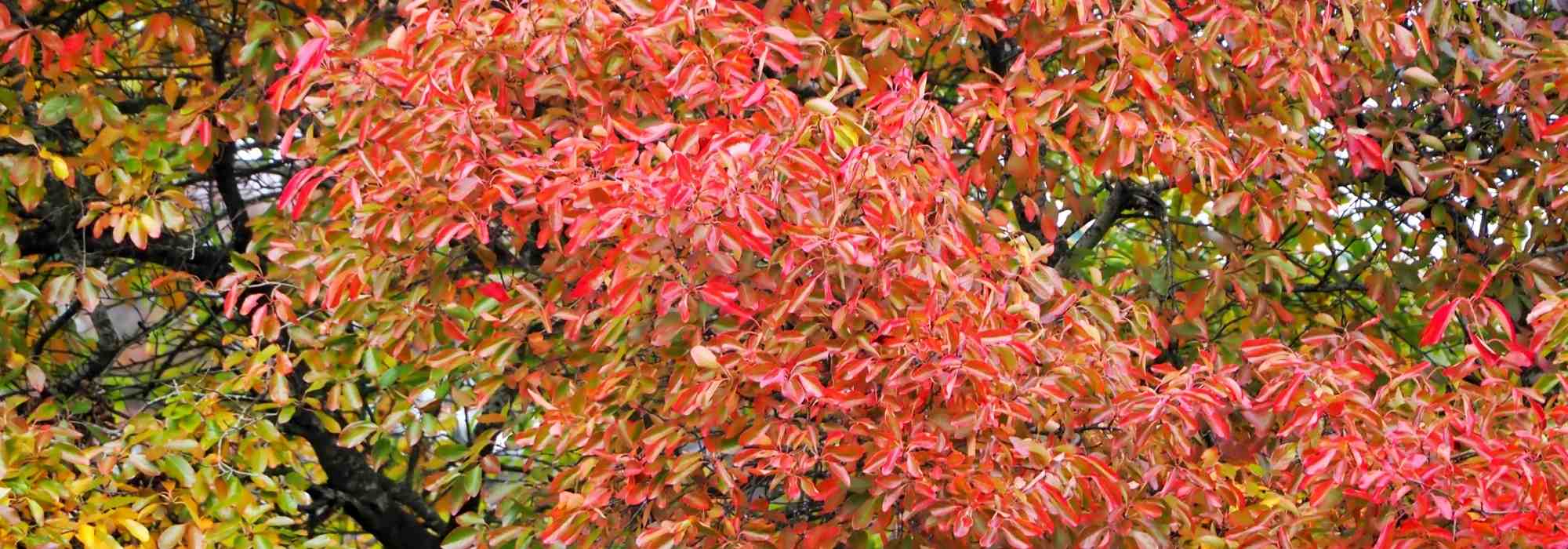
Nyssa, Black Gum or Tupelo: Planting and Care
Contents
The Nyssa in a few words
- It is one of the most beautiful trees to brighten up the garden throughout autumn
- Its foliage is remarkable when it bursts into fiery hues, not to mention its graphic bark and highly decorative fruiting!
- It thrives in fresh, non-calcareous soil and a well-chosen location
- Very hardy and resistant to diseases, it only fears drought
- There is a more compact form with weeping branches (‘Autumn Cascades’), well-suited to small gardens
The word from our expert
The Nyssa sylvatica, also known as Black Gum or Tupelo, is a remarkable deciduous tree celebrated for its stunning autumn foliage colours. It ranks among the most beautiful trees with colourful leaves for the garden, with its leaves turning gold, copper, and deep purple-red, or bright red in the case of the cultivar ‘Red Rage’, offering warm and spicy hues as early as late summer. Winter reveals its beautiful, finely wrinkled bark, while its green leaves enchant in spring and summer. While the tallest specimens, like the Nyssa sylvatica, can reach up to 20 metres in height, there are some smaller cultivars that rarely exceed 10 metres. There is even a more compact variety, ‘Autumn Cascades’, which grows no taller than 5 metres in all directions, making it ideal for smaller gardens. With a relatively slow growth rate, it can, however, live for over 600 years!
Highly hardy and disease-resistant, it thrives in permanently moist, well-drained, humus-rich soil, and does not tolerate drought or limestone.
A magnificent specimen tree when planted alone on a short grass meadow or as a shade tree in a strategic spot in the garden to showcase its elegant silhouette and autumn foliage, near a water feature, or even planted in a row as an avenue tree!

Nyssa sylvatica
Description and Botany
Botanical data
- Latin name Nyssa
- Family Nyssaceae or Cornaceae
- Common name Tupelo, Black Gum
- Flowering June-July
- Height 5 to 20 m
- Exposure Sun, partial shade
- Soil type Clay-loam (rich and light), moist to wet, acidic
- Hardiness -25 °C and beyond
The Nyssa sylvatica, also known as Black Gum or Tupelo, is a deciduous ornamental tree belonging to the Nyssaceae or Cornaceae family. Still rare in cultivation here, it is found naturally in the humid to swampy forest habitats of the eastern United States. This remarkable tree derives its name from Nyssa, the water nymph, as it requires moist to wet soil year-round to survive.
The genus Nyssa, now included in the Cornaceae family (the Dogwood family), comprises 9 species, including Nyssa sylvatica, the only representative in our latitudes. Along with the type species, only a few varieties of Tupelo are available in nurseries. The botanical classification of Nyssa is quite fluctuating, as it initially formed the Nyssaceae family on its own, which included only one species—Nyssa sylvatica—before being absorbed by the Cornaceae family (APG II and III). The Water Tupelo (Nyssa aquatica) is another species of Gum.
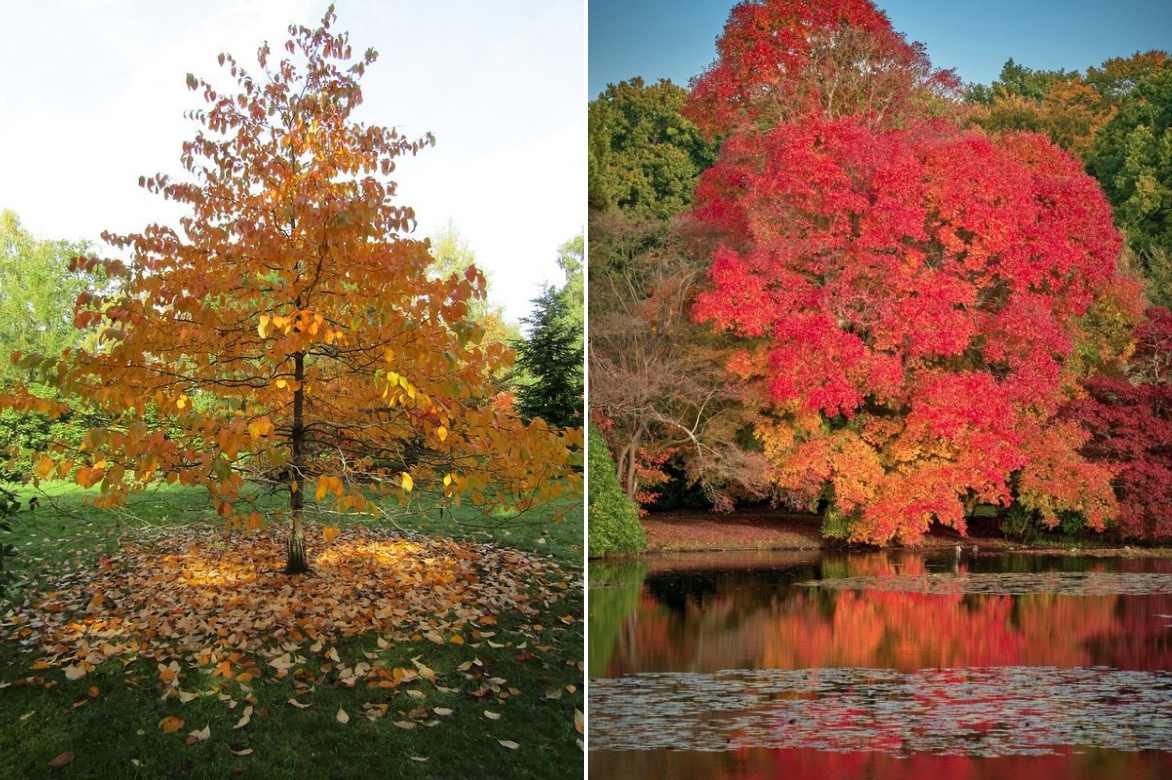
Nyssa sylvatica Tupelo (© Leonora Enking) and Nyssa aquatica
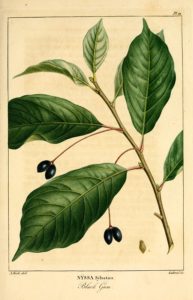
Nyssa sylvatica: botanical plate (1812)
While the Tupelo can reach 35 m in height in its native regions, it will rarely exceed 20 m in our climates. In our gardens, it will maintain a medium height between 9 and 15 m. Its slow growth is matched only by its exceptional longevity; it can live for over 600 years! It is one of those trees that never truly die.
Anchored by a deep taproot, the Black Gum forms a majestic tree with a pyramidal, elegant habit and a straight trunk covered in thick, greyish-brown bark that cracks with age. The bark peels off in long plates, resembling that of an oak or alligator skin, making it aesthetically pleasing even in winter.
In most Tupelos, the branches spread into a symmetrical crown that widens over time. ‘Autumn Cascades’ is the weeping version of the Tupelo, with elegantly trailing branches. Its uniqueness also lies in its reduced dimensions, reaching 5 m in height and 4 m in width.
This deciduous tree is particularly prized for its changing foliage, which dons sumptuous hues in autumn, filling the garden with warm, spicy colours. Dark green or yellow-green in spring, it becomes magnificent by late summer when its leaves ignite in flamboyant shades that vary by variety. From September to November, its attire ranges from bright yellow to orange, incandescent red, or purple. Nyssas are among the most beautiful autumn colourations, offering an unforgettable spectacle before the leaves fall.
The alternate leaves are obovate to oval and glossy. They emerge in spring at the axil of the leaves, at the tips of the main branches. They are borne on short reddish petioles, measure between 7 to 15 cm long, and feature slightly undulate margins and prominent veins. They are paler on the underside.
The insignificant flowering appears in June-July as small clusters of greenish-white, melliferous flowers with 5 petals. Hidden by the foliage, the nectar-rich flowers still attract numerous pollinators. They are followed by clusters of dark purple, shiny berries, 1 to 3 cm long, which delight birds.
Its hard wood is prized by woodturners for making pulleys or bowls. Additionally, deer are so fond of its leafy young plants that their appetite can hinder the establishment of Nyssas. The Tupelo honey, with its beautiful golden colour, has a unique buttery flavour with hints of cinnamon and anise.
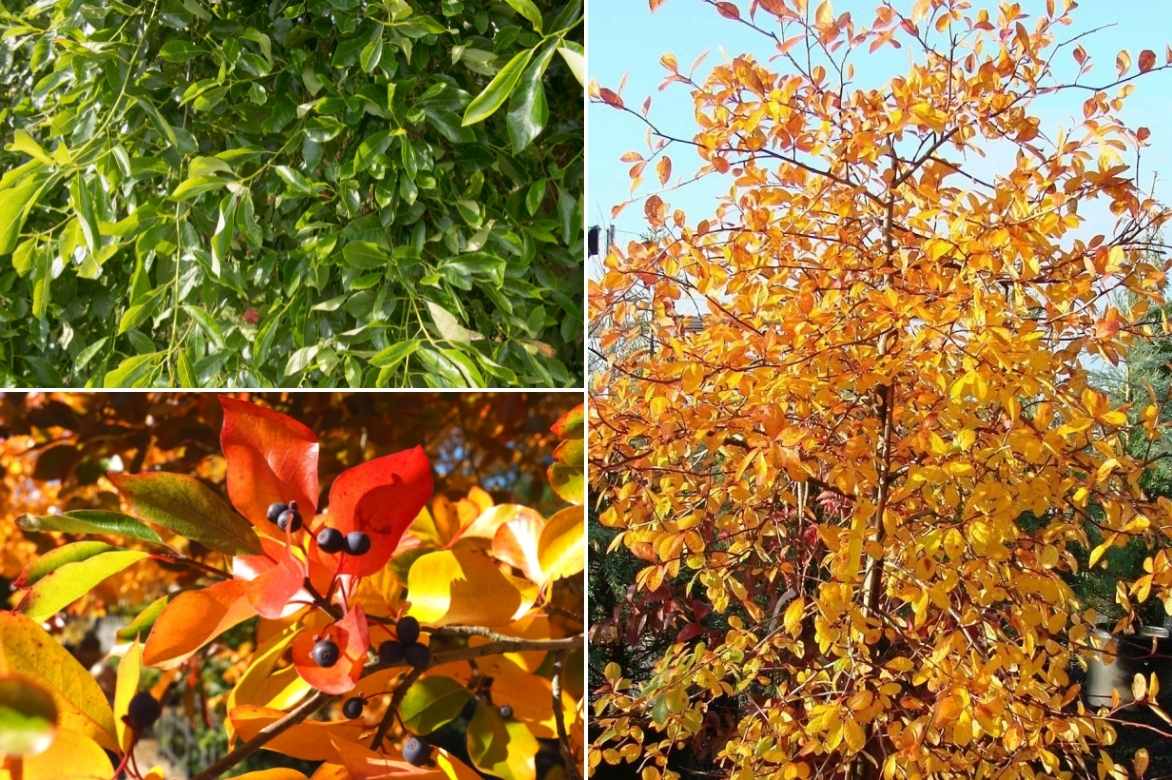
Summer foliage of Nyssa sylvatica, autumn berries, and compact form ‘Autumn Cascade’ on the right
Read also
Create a beautiful autumn gardenMain species and varieties
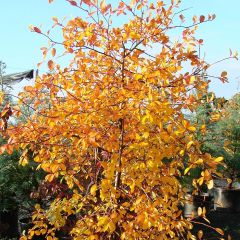
Nyssa sylvatica Autumn Cascades - Tupelo
- Flowering time July, August
- Height at maturity 5 m
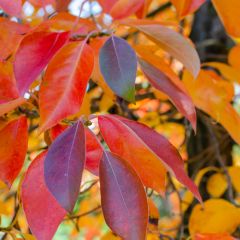
Nyssa sylvatica Red Rage - Tupelo
- Flowering time June, July
- Height at maturity 10 m
Discover other Nyssa - Black Tupelo
View all →Available in 1 sizes
Available in 1 sizes
Available in 2 sizes
Available in 1 sizes
Planting the Nyssa
Where to Plant It?
With excellent hardiness, the Nyssa or black tupelo can withstand winter temperatures as low as -25 to -30°C, making it suitable for planting in the coldest regions of our country. Native to humid zones and woodlands, it may be less comfortable in the overly dry Mediterranean regions, although it can tolerate a short period of summer drought. In gardens in the south of France, plant it in a sheltered, partially shaded spot with waterlogged soil. It is perfect for brightening up cool areas of the garden.
It is quite demanding when it comes to soil. Plant it in preferably acidophilous soil, which will enhance the colour of its leaves. It requires moist soil year-round, even very wet, provided it is well-drained in winter and fertile. Place it in full sun or a lightly shaded area. It tolerates wind well.
This tree does not transplant well at all; so, carefully consider its location before planting. To fully appreciate its remarkable autumn foliage, reserve it a well-exposed spot in the garden. It is known to be quite sensitive to urban pollution, and its deep taproot requires space commensurate with its vigorous growth. Opt for planting in a rural setting in a wild-style garden or a peri-urban area where it will thrive—it is not a good candidate for city gardens.
Nyssa sylvatica will be cultivated as an ornamental tree, either as a standalone feature on a vast short grass meadow or integrated into a flower bed. It will look magnificent beside a water feature, where it can reflect beautifully.
In a medium-sized garden, opt for smaller cultivars than the standard type, such as the Black Gum ‘Autumn Cascades’, which is narrow enough to enhance a bush cluster or a small pathway.
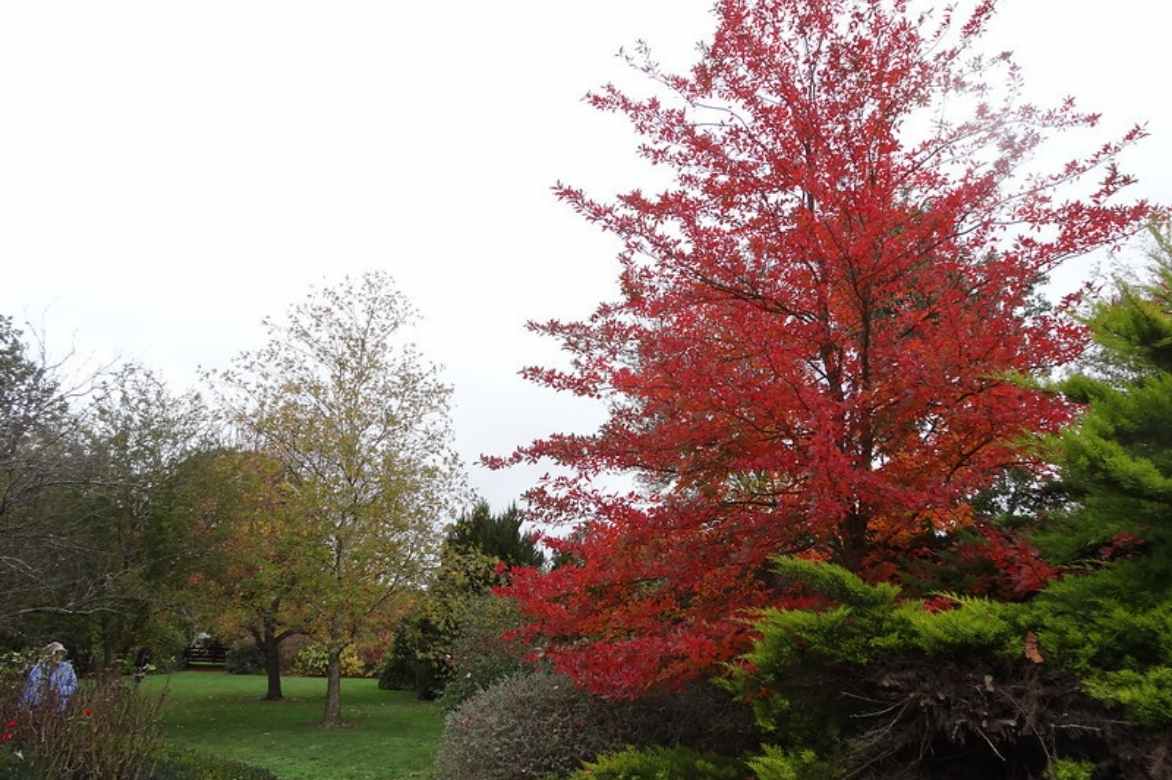
Nyssa sylvatica (© denisbin)
When to Plant the Tupelo?
Planting a Nyssa is best done in autumn, from September to November, to encourage root establishment before winter. Planting in spring, from February to April, is also possible, avoiding periods of frost or extreme heat.
How to Plant It?
When purchasing, choose a young plant that is not too tall, as a mature root system will not tolerate transplantation well. To give a Nyssa the best chance, the soil must be sufficiently rich, deep, and moist. In very chalky soil, we recommend adding heather soil at planting time. In heavy soil, plant it on a mound and ensure good drainage. Once established, avoid moving the tree, as its root system will not tolerate transplantation. Allow 8 to 10 metres of planting distance from another tree, or about 5 metres for smaller cultivars.
- Dig a hole 3 times wider than the root ball and loosen the soil to a depth of 80 cm with a fork
- Spread gravel at the bottom of the hole to aid drainage
- Mix half garden soil with compost and heather soil if the ground is chalky
- Add well-rotted compost
- Place the tree in the planting hole
- Plant at collar level without burying the root ball too deeply
- Stake if necessary
- Firm the soil and water generously until established, as well as during the first 3 years after planting
- Mulch around the base to retain moisture in summer
To ensure successful planting of your tree, check out our video!
Maintenance, pruning and care
If provided with sufficiently moist conditions and good drainage, the black gum requires very little maintenance once established. In summer, water once or twice a week for the first three years, especially during very hot and dry periods. The soil should never be dry: water deeply each time. Spread a good layer of organic mulch to keep the soil consistently cool.
Each spring, add compost or a good organic fertiliser at the base.
If necessary, consider protecting young plants from the appetite of deer.
The tupelo is not susceptible to diseases (including leaf spot) or parasites if planted in good conditions. However, in overly chalky soil, it may suffer from chlorosis, which causes yellowing of the leaves: add heather soil at the base to prevent its occurrence.
Pruning is not necessary; it simply involves annual maintenance at the end of winter, removing dead, dry, or damaged wood and low or poorly placed branches. Apply vegetable tar after each pruning, as every wound is a common entry point for pathogenous fungi.
Multiplication
The Nyssa can be propagated by sowing in a nursery in autumn (germination is random and requires stratification), by dividing suckers, and by layering. We recommend these last two propagation methods, which are simpler.
By separating suckers
The black gum tree tends to produce suckers and send out shoots around the mother plant.
- In autumn, separate the suckers with a spade
- Replant these young plants immediately in fresh, well-worked soil
By layering
This is done in autumn and allows you to obtain a new plant identical to the mother plant.
- Bend one of the lower branches down to the base of the tree
- Dig a furrow near the mother plant and the branch
- Remove the leaves from the part of the stem to be buried and make a 2 cm incision in the bark
- Lay the branch in the furrow
- Cover it with substrate, burying a portion so it can take root
- Fill in the furrow and secure the layer with metal hooks
- Lift the tip and stake the aerial part
- Water
- The buried part of the branch will root
- Once the layer is sufficiently rooted, cut the branch to replant it
Associate
If the Nyssa is remarkable for its dazzling autumn display in the midst of a short grass meadow, it remains easy to pair with other plants that thrive in the same humid environments, deep soils, and lime-free conditions. With its colourful foliage, it stands out for creating autumnal atmospheres. If you have a large space, you can compose a scene with spicy hues by pairing it with other trees and bushes with colourful foliage such as the Ginkgo biloba ‘Blagon’, Japanese maples, the Parrotia persica, the Liquidambar, the Liriodendron tulipifera or tulip tree, and the Winged Spindle (Euonymus alatus) to create a dazzling grove from September to November. At the end of the season, the leaves of a Katsura tree (Cercidiphylum japonicum) will also enhance its autumnal hues. The weeping form Nyssa sylvatica ‘Autumn Cascades’ will add a romantic touch to the backdrop of a bed with its gracefully trailing habit.
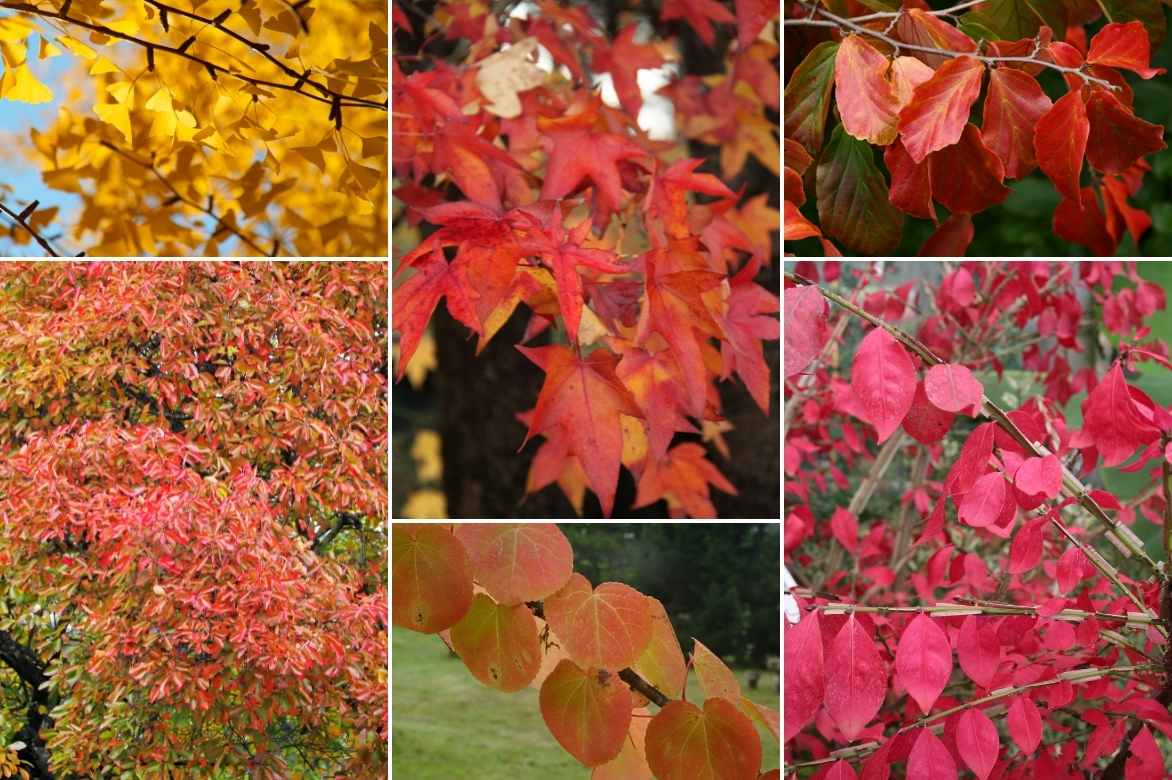
Nyssa sylvatica at the bottom left, paired with other autumn fires: Ginkgo biloba on the left, Liquidambar and Cercidiphylum in the centre, Parrotia persica and winged spindle on the right
This tree, which thrives in acidic soils, can serve as a backdrop for a mix of heather soil bushes such as rhododendrons and Chinese azaleas, with which it will coexist easily.
To highlight its resplendent foliage, plant it against a permanent green backdrop of conifers such as the Pinus peuce or Macedonian pine, or the Taxodium distichum (bald cypress).
In the foreground of a partially shaded bed, the Nyssa will be accentuated by a profusion of ferns such as the stunning Matteuccia orientalis, Onoclea sensibilis, or the Telypteris palustris, ideal for waterside scenes or around an ornamental pond, in dappled shade or sunlight.
Useful resources
- If you wish to create a grove of trees and bushes with spectacular autumn foliage, explore our collection of bushes with autumn colours
- Subscribe!
- Contents































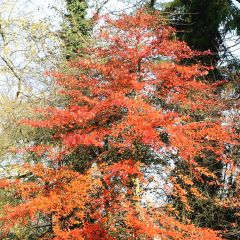



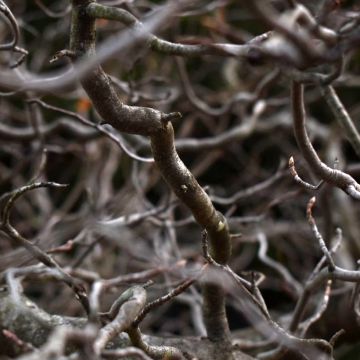
Comments